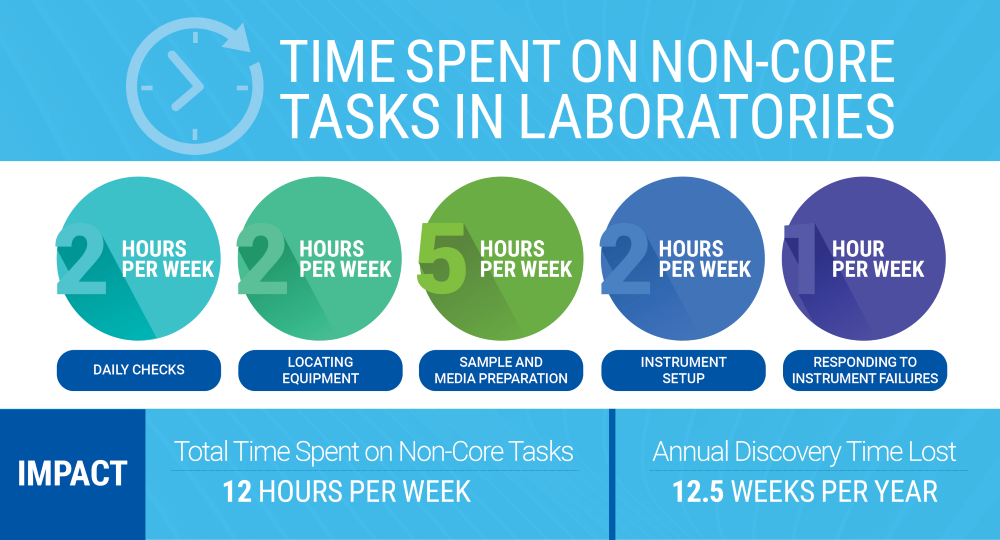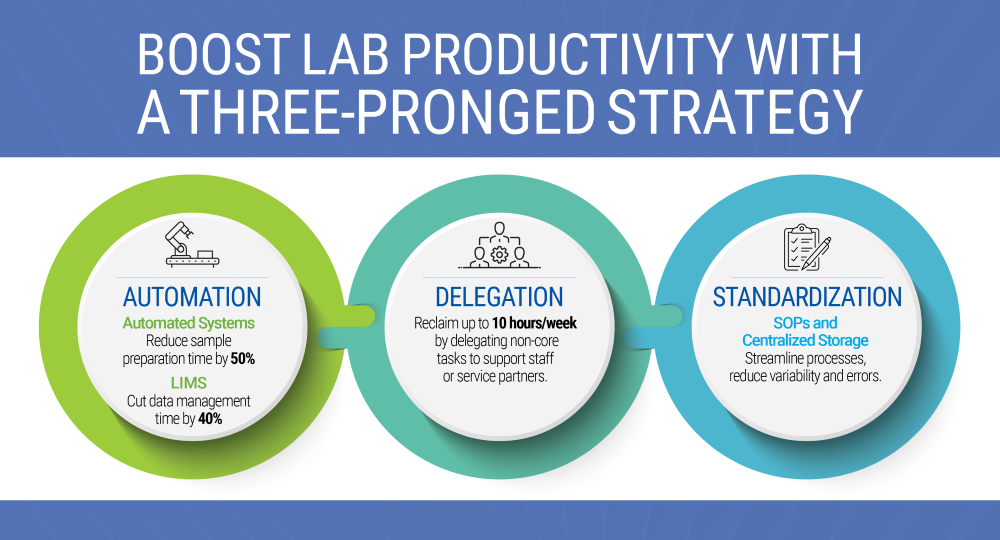Maximize Time for Innovation: Strategies for Reducing Non-Core Tasks in the Lab
In the fast-paced world of scientific research, time is an invaluable resource. Every minute spent on routine tasks is a minute taken away from groundbreaking drug discoveries and innovative R&D. For laboratories striving to push the boundaries of science, maximizing time for innovation is a necessity.
Yet, many scientists find their days consumed by non-core tasks such as reagent preparation, instrument setup, and consumables management. These essential but time-consuming activities detract from core scientific work, leading to decreased productivity and slowed innovation.
This blog will explore strategies to alleviate the burden of non-core tasks through optimized workflows. By implementing a structured approach to laboratory management, labs can free up valuable time for scientists to focus on innovation. Our discussion will delve into practical methods, including automation, delegation, and standardization, to enhance efficiency and productivity in the lab.

The Burden of Non-Core Tasks
In R&D and drug discovery, laboratories involve professionals such as research scientists, validation scientists, cell biologists, medicinal chemists, and computational chemists. These roles share a common burden: non-core tasks that consume a sizable portion of their daily schedule. Here are some specific examples:
- Research Scientists: Reagent preparation, setting up experiments, managing consumables.
- Validation Scientists: Equipment calibration, routine maintenance, documentation.
- Cell Biologists: Cell culture maintenance, media preparation, sterile techniques.
- Medicinal Chemists: Compound synthesis, purification processes, chemical inventory management.
- Computational Chemists: Data management, software setup, computational resource allocation.
Survey data reveals that 42% of lab workers spend over 5 hours per week on administration, compliance, and validation workflows. 40% spend 3-4 hours per week on quality control procedures. For instance, a research scientist might spend hours preparing reagents and setting up experiments, time better spent on analyzing results and accelerating drug discovery.
Further data shows that each scientist loses an estimated 12.5 weeks (about 3 months) of discovery time annually due to non-core tasks:
- Daily checks: 2 hours per week
- Locating required inventory: 2 hours per week
- Sample and media preparation: 5 hours per week
- Instrument setup: 2 hours per week
- Responding to instrument failures: 1 hour per week
These non-core tasks account for a huge portion of a scientist’s weekly schedule, leaving approximately 28 hours per week for core discovery activities. This diversion of focus can slow down scientific discoveries and hinder innovation. The repetitive nature of non-core tasks can also lead to burnout and reduced job satisfaction, impacting the overall efficiency and morale of the laboratory team.
Evaluating and Optimizing Workflows
Evaluating laboratory workflows is crucial for identifying inefficiencies and optimizing operations. By taking a systematic approach to analyze current processes, laboratories can pinpoint bottlenecks, streamline tasks, and enhance overall productivity. This proactive assessment is essential for freeing up valuable time for scientists to focus on core research activities.
Methods for Assessing Current Workflows
- Process Mapping:
- Create detailed maps of laboratory processes to visualize the flow of tasks.
- Identify areas where tasks overlap, are duplicated, or are unnecessary.
- Highlight steps that require considerable time or resources.
- Time Tracking:
- Implement time-tracking tools to monitor how much time is spent on various tasks.
- Collect data on the duration of both core and non-core activities.
- Use this data to identify tasks that are time-intensive and may benefit from optimization.
- Feedback and Surveys:
- Gather input from lab personnel through surveys and feedback sessions.
- Understand the challenges faced by distinct roles.
- Identify common pain points and suggestions for improvement.
Identifying Bottlenecks and Inefficiencies
Through workflow evaluation, laboratories can identify specific bottlenecks and inefficiencies that hinder productivity. For example, if time tracking reveals that a significant amount of time is spent on instrument setup, this indicates a potential area for automation or delegation. Similarly, process mapping may uncover redundant steps in sample preparation that could be streamlined.

Implementing a Three-Pronged Strategy
To maximize laboratory productivity and minimize the burden of non-core tasks, implementing a three-pronged strategy—automation, delegation, and standardization—can be highly effective. Here is a closer look at each component:
Automation: Leveraging Technology to Automate Repetitive Tasks
- Instrument Automation: Utilize automated systems for routine tasks such as reagent dispensing, sample analysis, and data collection. Automated pipetting systems can significantly reduce the time spent on sample preparation.
- Data Management: Implement laboratory information management systems (LIMS) to streamline data entry, storage, and analysis, reducing manual data handling and minimizing errors.
- Routine Checks: Use automated monitoring systems for daily verification of equipment such as scales and meters, ensuring consistent performance without manual intervention.
Delegation: Utilizing Support Staff or Scientific Service Partners for Routine Tasks
- Scientific Service Partners: Engage specialized service partners to handle non-core tasks such as equipment maintenance, consumables management, and regulatory compliance. This allows in-house scientists to focus on core research activities.
- Support Staff: Train and delegate routine tasks to lab technicians or support staff. For example, technicians can manage sample preparation, media preparation, and routine instrument setup, freeing up scientists for more complex tasks.
- Outsourcing: Consider outsourcing specific tasks that require specialized expertise, such as advanced data analysis or complex equipment calibration, to external service providers.
Standardization: Creating Standardized Protocols to Streamline Processes
- Standard Operating Procedures (SOPs): Develop and implement SOPs for routine tasks to ensure consistency and efficiency, reducing variability and errors.
- Centralized Storage: Establish centralized storage systems for consumables and reagents. Clearly labeled and organized storage reduces time spent locating materials and prevents overstocking or stockouts.
- Uniform Methods: Standardize experimental methods and procedures across the lab to ensure all team members follow the same protocols, reducing confusion and increasing efficiency.
By integrating automation, delegation, and standardization into laboratory workflows, labs can significantly reduce the time spent on non-core tasks. This approach enhances overall productivity, improves the quality and consistency of scientific work, and boosts morale and job satisfaction among lab personnel.

Potential Benefits and Estimated Impacts
Implementing the three-pronged strategy of automation, delegation, and standardization has led to significant benefits in laboratory efficiency and productivity:
- Automation: Automated systems for routine tasks save considerable time. For instance, automated pipetting systems can reduce sample preparation time by up to 50%, and LIMS can reduce data management time by around 40%.
- Delegation: Delegating non-core tasks to trained support staff or scientific service partners has enabled scientists to reclaim up to 10 hours per week.
- Standardization: Implementing SOPs and centralized storage has streamlined processes, reducing the time spent searching for materials or repeating tasks due to inconsistencies.
With the reduction of non-core tasks, scientists have more time to dedicate to core research activities such as assay development, data analysis, and hypothesis testing. This shift has led to faster project completion and increased pipeline of potential therapeutics. Streamlined workflows have minimized bottlenecks and eliminated task duplication, improving overall lab efficiency, and enhancing the quality and consistency of scientific output. Additionally, the alleviation of repetitive tasks has prevented burnout and boosted job satisfaction among lab personnel, contributing to a more motivated and productive team.
The Role of Scientific Service Partners
Scientific service partners play a crucial role in enhancing laboratory productivity by taking on non-core tasks and providing specialized expertise. These partners act as extensions of the laboratory team, offering a range of services that allow scientists to focus on their core research activities. Here is how they can support laboratories:
- Expertise and Specialization: Scientific service partners bring specialized knowledge and skills to handle complex and routine tasks efficiently. Their teams consist of experienced professionals adept at managing equipment calibration, maintenance, regulatory compliance, and more.
- Time and Resource Optimization: By outsourcing tasks such as instrument maintenance, reagent preparation, and consumables management, laboratories can free up critical time for their scientists. This shift allows researchers to concentrate on high-value activities like experimental design, data analysis, and innovation.
- Enhanced Efficiency and Productivity: Scientific service partners streamline laboratory operations by implementing best practices and standardized procedures. This leads to more efficient workflows, reduced downtime, and minimized disruptions. Services such as inventory management, equipment validation, and compliance monitoring ensure that laboratories operate smoothly and adhere to regulatory standards.
Practical Tips for Reducing Non-Core Tasks
Step-by-Step Guide to Identifying and Categorizing Tasks
To effectively reduce non-core tasks and optimize laboratory workflows, it is essential to identify and categorize the tasks that consume considerable time. Here is a step-by-step guide:
- Conduct a Task Audit:
- List all the tasks performed in the laboratory, both core and non-core.
- Track the time spent on each task over a typical week to understand their impact on overall productivity.
- Categorize Tasks:
- Core Tasks: Activities related to scientific research and innovation, such as experimental design, data analysis, and hypothesis testing.
- Non-Core Tasks: Routine and administrative activities, including reagent preparation, instrument maintenance, consumables management, and compliance documentation.
- Prioritize Tasks for Optimization:
- Identify non-core tasks that consume the most time and resources.
- Evaluate which tasks can be automated, delegated, or standardized to improve efficiency.
Tips for Selecting the Right Service Partners
- Expertise and Reliability: Choose service partners with a proven record of accomplishment in your specific scientific field. Look for partners who offer comprehensive services, including equipment maintenance, compliance management, and technical support.
- Customization and Flexibility: Ensure the service partner can tailor their offerings to meet your lab’s unique needs. Flexible service agreements and customizable packages can provide better value and support.
- Communication and Support: Opt for partners who provide excellent customer support and clear communication. Regular updates and responsive service are crucial for maintaining smooth laboratory operations.
Selecting the right scientific service partners can significantly reduce the burden of non-core tasks. By following the steps to identify and categorize tasks, and carefully choosing reliable service partners, laboratories can streamline their operations, allowing scientists to focus more on core research activities and innovation.
Conclusion
Maximizing laboratory productivity and innovation requires a strategic approach to minimizing non-core tasks. By understanding the burden these tasks place on scientists, evaluating workflows, and implementing a three-pronged strategy—automation, delegation, and standardization—laboratories can significantly enhance lab efficiency.
The journey towards optimized laboratory workflows begins with a thorough task audit and categorization. Identifying the tasks that consume valuable time and finding ways to automate, delegate, or standardize them can free up scientists to focus on core research activities. The potential benefits, including increased productivity, improved morale, and faster scientific progress, make this effort worthwhile.
For a more detailed exploration of strategies to maximize laboratory productivity, we encourage you to download our eBook, “MAXIMIZING LABORATORY PRODUCTIVITY WITH PROFESSIONAL SCIENTIFIC SERVICES.” This comprehensive guide offers actionable insights and practical tips to help your laboratory thrive.
Ready to transform your lab? Contact us to get started!
